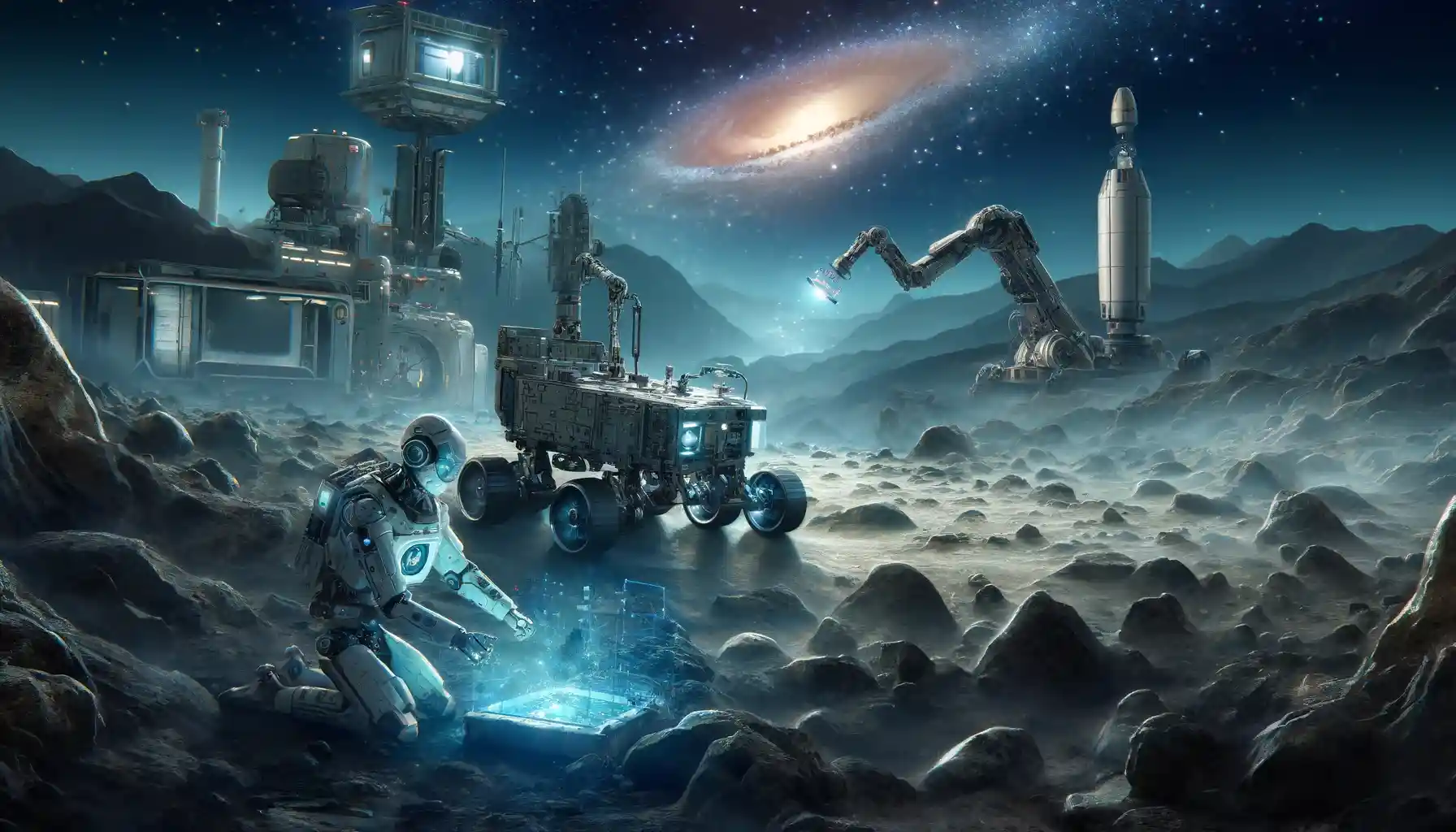Space exploration has long captivated the human imagination, pushing the boundaries of what is possible and inspiring generations to look to the stars. In recent decades, robotics in space exploration has become a cornerstone of our quest to understand the cosmos. Robotic systems have enabled us to send probes to distant planets, conduct scientific experiments on the International Space Station, and even pave the way for future human missions to Mars. This article delves into the evolution, technology, applications, challenges, and future of robotics in space, offering insights into how these sophisticated machines are transforming our understanding of the universe.
Table of Contents
Introduction to Space Robotics
Space robots are specialized machines designed to operate in the harsh and unforgiving environment of space. From the rovers that traverse the Martian surface to the robotic arms on space stations, these machines are tasked with performing scientific research, maintenance, exploration, and even construction beyond Earth’s atmosphere.
Robots in space exploration serve multiple purposes:
- Safety: They perform tasks too dangerous for human astronauts, such as repairing satellites in orbit or exploring alien terrain.
- Efficiency: Robots can operate continuously without fatigue, gathering vast amounts of data over extended periods.
- Cost-Effectiveness: Deploying robots reduces the need for expensive human spaceflights for certain missions, making space exploration more sustainable.
Key Technologies Behind Space Robots
Autonomy and AI
Space exploration robots rely on autonomous systems to navigate and perform tasks without constant human intervention. Due to the significant communication delays between Earth and space (ranging from minutes to hours), these robots must make real-time decisions independently.
Artificial Intelligence (AI) plays a pivotal role in these autonomous capabilities:
- Path Planning: AI algorithms enable rovers to navigate rocky terrain, avoid obstacles, and optimize routes on planets like Mars.
- Scientific Decision-Making: Onboard AI can analyze data, detect anomalies, and decide which samples to collect or which experiments to conduct.
- Adaptive Learning: Machine learning allows robots to learn from their environment and improve their performance over time.
Sensor Systems
Robotic explorers are equipped with a variety of sensors to perceive their environment, including:
- Cameras and Spectrometers: High-resolution cameras capture images, while spectrometers analyze the composition of rocks, soil, and atmosphere.
- LIDAR and RADAR: These systems measure distances and create detailed 3D maps of the surroundings, crucial for navigation and terrain analysis.
- Environmental Sensors: Temperature, radiation, pressure, and humidity sensors help monitor the conditions of the space environment and ensure the robot’s survival.
These sensors feed data to the robot’s processors, which in turn inform navigation, scientific analysis, and mission planning.
Notable Missions and Applications
Planetary Rovers
Planetary rovers like NASA’s Curiosity and Perseverance on Mars represent some of the most iconic examples of robotics in space exploration. These rovers perform a multitude of tasks:
- Geological Analysis: Equipped with drills, spectrometers, and cameras, rovers analyze rock and soil samples, searching for signs of past life and water.
- Navigation and Mapping: Using stereo vision and LIDAR, rovers create detailed maps of the Martian terrain, planning paths around obstacles and hazardous areas.
- Environmental Monitoring: Rovers monitor weather patterns, radiation levels, and atmospheric conditions to inform future missions and aid scientific understanding.
Satellite Servicing and Assembly
Robots are increasingly used for satellite servicing, repair, and even assembly in orbit:
- Robotic Arms: On the International Space Station (ISS), robotic arms like Canadarm2 assist with docking spacecraft, manipulating payloads, and performing maintenance tasks.
- On-Orbit Assembly: Future missions envision robots assembling structures or satellites directly in space, reducing launch costs and enabling larger, more complex missions.
- Refueling and Repair: Concepts like robotic servicing vehicles aim to refuel and repair satellites, extending their operational lifetimes and reducing space debris.
Challenges in Space Robotics
Harsh Environments
Space robots must endure extreme conditions: intense radiation, severe temperature fluctuations, dust storms on Mars, and the vacuum of space. These conditions can damage delicate electronics and mechanical parts, necessitating robust design and extensive testing.
Communication Delays
Due to the vast distances in space, communication between robots and Earth-based controllers can experience significant delays. This limitation forces robotic systems to function autonomously, complicating design and requiring sophisticated onboard AI.
Limited Resources and Energy
Robots in space must operate with limited energy supplies, often relying on solar power or battery storage. Efficient energy management and lightweight design are crucial to maximize operational lifespan and mission success.
Maintenance and Repair
Once a robot is deployed in space, servicing it is exceptionally challenging and expensive, if not impossible. Therefore, robots must be highly reliable and self-sufficient, with redundancy built into critical systems to mitigate failures.
Future Trends and Innovations
Swarm Robotics in Space
The concept of deploying swarms of small robots working together is gaining traction. Swarm robotics can enhance exploration by enabling simultaneous data collection over vast areas, redundancy in case of individual robot failure, and dynamic adaptation to unforeseen challenges.
Advanced AI and Machine Learning
The next generation of space robots will further leverage advanced AI algorithms to analyze data onboard, make complex decisions, and even develop new hypotheses without direct human guidance. Improved learning algorithms will make robots more adaptable to unknown environments.
Improved Autonomy and Navigation
Future robots will feature enhanced autonomous navigation capabilities, using improved sensor fusion, real-time mapping, and obstacle avoidance techniques. Developments in quantum computing and edge AI may offer breakthroughs in processing power for space exploration robots.
Human-Robot Collaboration in Space
As missions extend beyond Earth orbit, robots will play a crucial role in assisting astronauts. Collaborative robots—designed to work alongside humans safely—could support tasks such as habitat construction on the Moon or Mars, scientific experiments, and routine maintenance, increasing mission efficiency and safety.
Innovative Power Solutions
Emerging energy technologies, like advanced solar panels, radioisotope thermoelectric generators (RTGs), and novel battery materials, will extend the operational lives of space robots and expand their capabilities.
Conclusion
Robotics in space exploration represents a monumental shift in how we understand and interact with the cosmos. By combining autonomy, advanced sensing, AI, and resilient design, robots are not just tools but active explorers that push the boundaries of human knowledge. They navigate harsh terrains, perform delicate scientific experiments, and pave the way for future human presence on other planets.
The challenges are significant—harsh environments, limited resources, and the need for robust autonomy—but so are the rewards. With ongoing innovations in AI, materials science, and energy solutions, the next generation of space robots promises to be more capable, reliable, and collaborative. As humanity continues its quest to explore the final frontier, robotic navigation and mapping, autonomous decision-making, and innovative designs will remain at the forefront of this exciting journey.
For further reading on space robotics, cutting-edge research, and mission updates, visit the Jet Propulsion Laboratory (JPL). JPL provides extensive resources on robotics missions, technological advancements, and the latest news in space exploration.

